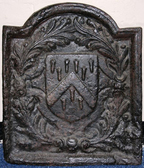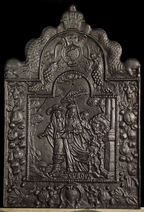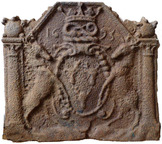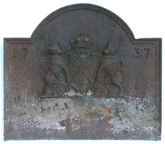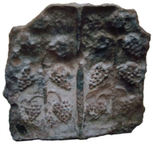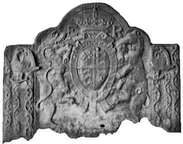-
717
Description: Arched rectangular central panel with bead-on-fillet edging; femal figure holding scales in her right hand and a sword in her left hand, foliage and clouds behind; arched rectangular border with fillet edging; from a central bow with three tassels at the top, two suspended festoons of flowers, each running through a ring under the top corners, and continuing along the bottom; on top, a central cartouche between mirrored foliate scrolls.
Notes: The female is an allegorical representation of Justice.
Copies of this fireback are known.
- Decoration tags:
- 'Dutch' (shape)
- fillet (edging)
- whole carved pattern
- pictorial
- allegorical
- humans
Manufactured: in the early-18th century in England.
Current location: not known.
- Attached to series:
- British 'Dutch' style firebacks
-
1157
Description: Arched rectangular shape; ovolo-moulded edging; a shield with the arms of the Grocers' Company on a cartouche, surrounded by four sprays of olive leaves.
Notes: The blazon of the arms is: Argent, a chevron gules between nine cloves six in chief and three in base proper. The arms were granted in 1532. The style of the fireback owes something to the design of French firebacks of the mid-17th century.
Copies of this fireback are known.
Arms: Worshipful Company of Grocers
- Decoration tags:
- rectangular with round arch (shape)
- ovolo (edging)
- whole carved pattern
- heraldic
- armorial
- plants
Manufactured: in the mid-17th century in England.
Current location: not known.
- Attached to series:
- Livery company firebacks
-
719
Description: Arched rectangular central panel; bead-and-pellet edging; pictorial scene of a male figure seated in a chariot, his left arm resting on the side of the chariot, his right hand holding a sceptre at arm’s length, the chariot drawn by two lions across a ground with small bushes; clouds above with the personification of the wind blowing to the left; arched rectangular border with fillet edging; repeated, linked scroll-work on all sides; on top a vase of fruit between two mirrored serpents; on each side, rectangular extension panel with a curved top copying the side borders.
Notes: A variant has no extension panels; similar to other designs incorporating figures in chariots, though not from the same series.
- Decoration tags:
- 'Dutch' (shape)
- fillet (edging)
- whole carved pattern
- extension panels
- pictorial
- allegorical
- humans
Manufactured: in the early-18th century in England.
Current location: not known.
- Attached to series:
- British 'Dutch' style firebacks
-
720
Description: Arched rectangular central panel with bead-on-fillet edging, pictorial representation of a man and woman walking, behind the woman a child holds her train and a young person carries a parasol; from behind a column on the right, a horse's head is visible, a tree stands to the left, at the foot of the scene is the word 'EVROPA'; tall-arched rectangular border with fillet edging; at top of arch, a lion's head above a ring, with descending grape vines on each side; at each side, a festoon of fruit suspended on a ribbon from a lion's head; at the bottom, an oval cartouche between flowers; on top, a Holy Roman Imperial crown between two descending dolphins.
Notes: The pictorial scene is based on an engraving c.1642 of Friedrich Wilhelm, Elector of Brandenburg, and his wife, Luise Henriette of Oranje-Nassau, by Mathias Czwiczek; one of series of firebacks depicting allegories of the four continents.
Copies of this fireback are known.
Inscription: EVROPA
- Decoration tags:
- 'Dutch' (shape)
- fillet (edging)
- whole carved pattern
- pictorial
- architectural
- text
- humans
- plants
Manufactured: in the mid- to late-17th century in the Siegerland area of Germany.
Current location: not known.
- Attached to series:
- 'Dutch' Miscellaneous Firebacks
- 'Dutch' Continents firebacks
-
818
Description: Quasi-arched rectangular shape; on a ground, an armorial achievement comprising a central cartouche on which is an oval shield bearing the arms of the Cavendish family, with graduated bead edging; supporters, two stags rampant; above the cartouche, on a wreath a coiled snake crest surmounted by an earl’s coronet; the date split either side of the crest; to each side, a column with foliate capital supporting a three-sided arch with ovolo-moulded edging, on each shoulder of which is a flaming orb.
Notes: The arms are those of the Earls of Devonshire. However, the date relates to William Cavendish (1640-1707), previously 4th Earl and created 1st Duke of Devonshire in 1694. An earlier casting (no. 246) has a date of 1657, the second pair of numerals having been changed. Christie's auction 3 Dec 2014 lot 15 (dated incorrectly as 1693) (£1,875).
Inscription: 1695
Arms: William Cavendish, 1st Duke of Devonshire, as 4th Earl of Devonshire
- Decoration tags:
- rectangular with three-facetted arch (shape)
- complex individual (edging)
- whole carved pattern
- individual numbers
- armorial
- text
Manufactured: in 1695 in England.
Current location: not known.
- Attached to series:
- Personal armorial firebacks
- Cavendish arms series
-
819
Description: Arched rectangular shape; cavetto moulding (top and sides); date in top corners; shield, supporters, coronet and motto of the Barony of Bergavenny.
Notes: The arms are those of William Nevill, 16th Baron Bergavenny, of Kidbrooke Park, Forest Row, Sussex; the arms have been modified by the omission of the motto below the compartment.
Inscription: 17 37
Arms: William Nevill, 16th Baron Bergavenny
- Decoration tags:
- rectangular with round arch (shape)
- cavetto (edging)
- carved stamps
- individual numbers
- armorial
- text
Manufactured: in 1737 in the Weald area of England.
Current location: in private hands, Greenham, Somerset, England.
- Attached to series:
- Bergavenny firebacks
- Personal armorial firebacks
-
835
Description: Rectangular central panel with fillet edging; poorly modelled standing figure possibly of Diana, goddess of hunting, holding a bow in her left hand and an arrow in her right hand, on a low plinth; border with fillet edging along sides and bottom, with mirrored vine tendril and leaves on each side; date split either side of leaves at bottom; on top, symmetrical swirled foliate arrangement.
Notes: A characteristic small fireback from the period of the changeover to coal-fired domestic heating.
Inscription: 17 33
- Decoration tags:
- rectangular with ornate arch (shape)
- fillet (edging)
- whole carved pattern
- pictorial
- mythological
- text
- humans
- plants
Manufactured: in 1733 in England.
Current location: not known.
- Attached to series:
- Late pictorial series (all)
-
847
Description: Originally rectangular; two identical panels, each with braid edging, a vine standard with six bunches of grapes and a cluster at the top.
Notes: One of an unusual series formed from separate panels arranged, in this instance, with repeated panel; fire-damaged, hence the distorted shape. Recovered after the fire at Nymans, Handcross, Sussex in 1947.
- Decoration tags:
- rectangular (shape)
- simulated rope (edging)
- carved pattern panels
- plants
Manufactured: in the late-16th century in the Weald area of England.
Current location: not known.
- Attached to series:
- Armada series
-
848
Description: Arched rectangular shape with rounded corners; ovolo within fillet moulding all round; oval Tudor royal shield with garter surrounding, topped with a royal crown; dragon and greyhound supporters; initials split by crown; inscription on a fillet between legs of supporters, behind garter finial; motto on an Ionic plinth at bottom; two rectangular side panels, each with a bird stamp (probably a swan, a Lancastrian badge) above a vine strip stamp repeated three times vertically.
Notes: One of two known variants of the John Harvo fireback incorporating extension panels with vine strips and 'swans'; the positions of the swans vary slightly between the two variants. Formerly at the old post office, Ticehurst, Sussex.
Inscription: E R / HONY SOIT QUE MAL Y PAYNCE
Arms: Tudor royal - prob. Edward VI
- Decoration tags:
- rectangular with round arch (shape)
- carved pattern panels
- whole carved pattern
- extension panels
- armorial
- royal
- animals
- objects
Manufactured: in the mid- to late-16th century possibly at Pounsley Furnace, Framfield in the Weald area of England.
Current location: not known.
-
901
Description: Quasi-Arched rectangular shape with cyma reversa shoulders; ovolo edging; stylised lion passant guardant; crowned rose with leaf and stem on left, crowned fleur de lys on right, thistle with leaves above centre; three right-facing scrolls at base; down-facing scroll, with staple, on right side; date split between bottom corners; initials below date, bottom right.
Notes: Blatantly Royalist in its symbolism, a variant (no. 763) is dated (perhaps less convincingly) 1649. Numeral style, initials, leaf depiction and the stapled scroll are typical features of firebacks made from patterns by the same maker. A later version of the same subject, but with a different shaped plate and without the fleur-de-lys, is also known (see 'Royalist series'). M. A. Lower writes of this design of fireback being cast at Waldron Furnace in Sussex (Lower, 1849, p.219). Inferior copies of this fireback were advertised in Kings Worthy Foundry's (Winchester) catalogue in the mid-20th century.
Copies of this fireback are known.
Inscription: 16 41 / IM
- Decoration tags:
- rectangular with round arch (shape)
- ovolo (edging)
- whole carved pattern
- heraldic
- royal
- text
- animals
Manufactured: in 1641 possibly at Brede Furnace in the Weald area of England.
Current location: in private hands, Wandsworth, London, England.
- Attached to series:
- IM series
- Hooked '1' series
- Stapled scroll series
- Brede group

